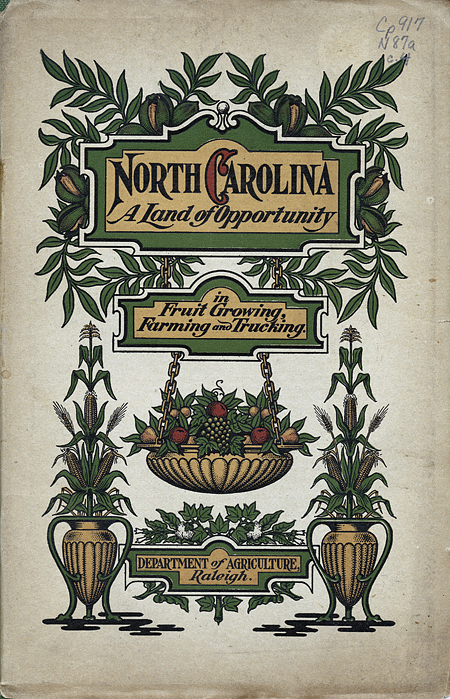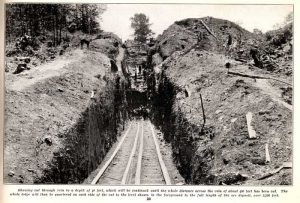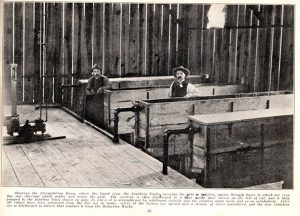Several new titles just added to “What’s New in the North Carolina Collection?” To see the full list simply click on the link in this entry or click on the “What’s New in the North Carolina Collection?” link under the heading “Pages” in the right column. As always, full citations for all the new titles can be found in the University Library Catalog and they are all available for use in the North Carolina Collection Reading Room.
Month: July 2009
Splashy, North Carolina
Cataloging our collection’s North Carolina phone books provided a great education for me about some of our State’s interesting and unique town names. While trying to catalog a troublesome Rockingham County telephone book, whose title and name changes were causing me a great deal of head-scratching and temple rubbing, I unearthed a fun factoid concerning one of these “interesting and unique town names”, which made it all worthwhile.
In 1968, the “Leaksville, Spray, Draper phone book” changed to the “Eden phone book.” Unfamiliar with this area of North Carolina, I went straight to the North Carolina Gazetteer, by William S. Powell, to help clear up my confusion. I found that a merger of the three towns had occurred, resulting in a new town, which was named Eden. This cleared up my telephone book title confusion, but while searching for this, I also found an entertaining piece of North Carolina trivia about Spray: according to Powell’s Gazetteer, the area in north Rockingham County was “settled about 1813 and known first as Splashy from the water thrown up by a water wheel at a local mill; name later changed to the more sophisticated Spray.” Splashy, North Carolina … sounds like a nice cool place to have been on a hot summer day!
He was one Progressive Farmer boy

In 1889, Chatham County farm boy Clarence Poe, age 18, became editor of the Progressive Farmer, a struggling eight-page weekly in Raleigh.
In an era when Southern agriculture still paid more heed to phases of the moon than to science, Poe, who had never finished high school, almost single-handedly popularized “book farming.” The Progressive Farmer grew to a circulation of nearly 1.5 million and at one time ran more advertising than any other monthly magazine in the nation.
Poe not only battled cattle ticks, hookworm and hog cholera (and encouraged youngsters to grow more corn, as in this pinback button from the collection), but also took stands against child labor, usury, and lynching. He remained actively involved until suffering a fatal stroke in 1964 at age 83.
The decline of the small farm gradually undercut the circulation and influence of the Progressive Farmer—in contrast to its extraordinarily prosperous 1966 offshoot, Southern Living magazine.
Do myths hold secret to eternal life?
Before we’ve wandered too far down the road from Michael Hill’s call for “major myths of North Carolina history” (June 19 Miscellany), let’s consider three myths that make up in stubbornness whatever they lack in size:
- “Pulitzer” for Lamar Stringfield, founder of N.C. Symphony
- Nicks in the Capitol steps
- Hospital’s alleged refusal to treat Dr. Charles Drew
Charlotte vs. Raleigh for “social supremacy”

On this date in 1951, 23 Charlotte debutantes, “looking as gracious as any ante-bellum belles,” appear on the cover of Life magazine.
Inside, Life devotes a four-page spread to Charlotte’s recent challenge to “the social supremacy” of Raleigh:
“For many a decade an old social tradition has plagued North Carolina’s country belles: the only affair that would surely stamp them debutantes was Raleigh’s big Terpsichorean Ball. Once every year young ladies all over the state would keep a wistful eye on the mails for Raleigh’s cherished invitation. Then, hearts aflutter, a few of them would set out for the capital and twirl around for a while in white-gloved elegance at the one dance that really counted.
“But others thought it unfair that Raleigh should set itself up to be the social arbiter of the state. So last year the ladies of Charlotte decided to throw off the yoke. Charlotte, they reasoned, was bigger, richer and nicer than Raleigh, and should have a say of its own. They seceded from Raleigh society and announced their plans for the Charlotte Debutante Ball.
“This June the ball’s second staging proved Charlotte was ready to give the Terpsichorean a real race for prestige. Charlotte’s debutantes were every bit as dainty and decollete [as Raleigh’s], Charlotte’s young men were just as gracious.”
Footwear for Southerners of all kinds

“The South is hypersensitive to criticism which emanates from the outside, and professional Defenders-of-the-South never fail to take advantage of every opportunity to aggravate this unfortunate psychopathic condition.
“Symptomatic of this was the reaction which followed the remark by Frances Perkins that a ‘social revolution would take place if shoes were put on the people of the South.’ ‘Why, even the mules of the South wear shoes!’ indignantly rejoined Senator [Josiah] Bailey of North Carolina.
“‘There is a considerable colored population in the South who would regard it as a distinct punishment to be required to wear shoes,’ added Senator Duncan Fletcher of Florida.”
[from Southern Exposure by Stetson Kennedy (1946)]
(This episode goes unmentioned in Kirstin Downey’s just-published The Woman Behind the New Deal: The Life of Frances Perkins, FDR’S Secretary of Labor and His Moral Conscience.)
Mack’s Super Truck Station … “It is one of the Better stops.”
Recession Proof Plan: Buy The Howie Gold Mine
As I was shelving in the stacks a few days ago, I noticed the broadside below. Then, it hit me! To avoid the pitfalls, trials, and tribulations of our current recession, I’ll just buy a gold mine. I wonder…is this one still on the market?
If I decide to follow through with this plan, I should probably check out the resources that we have on the Howie Mine:
Plans of levels of Howie Mine, Union County, North Carolina [cartographic material]
The Howie Mining Company : incorporated.
The item above has some very interesting images, which I’ll share below. Click on the images to see a larger version.
A Land of Opportunity
 The beautiful cover of the above pamphlet, North Carolina: Conditions Conducive to Farming, Trucking, Fruit Growing, Stock Raising, etc., in the Old North State surfaced when I was searching for materials to use in the exhibit Cultivating “The Great Winter Garden”: Immigrant Colonies in Eastern North Carolina, 1866-1940. I didn’t include it in the exhibit, however tempting the artwork, because it didn’t address immigration even though it did touch on other related topics presented in the exhibit such as intensive farming. In the pamphlet, the Department of Agriculture advocated intensive farming, but on a large scale, contrary to the smaller intensive farming promoted by the Ten Acres Enough perspective of Hugh MacRae, a key focal point of the exhibit. With the first week of summer well underway, now seemed like a good time to bring it to the light of day.
The beautiful cover of the above pamphlet, North Carolina: Conditions Conducive to Farming, Trucking, Fruit Growing, Stock Raising, etc., in the Old North State surfaced when I was searching for materials to use in the exhibit Cultivating “The Great Winter Garden”: Immigrant Colonies in Eastern North Carolina, 1866-1940. I didn’t include it in the exhibit, however tempting the artwork, because it didn’t address immigration even though it did touch on other related topics presented in the exhibit such as intensive farming. In the pamphlet, the Department of Agriculture advocated intensive farming, but on a large scale, contrary to the smaller intensive farming promoted by the Ten Acres Enough perspective of Hugh MacRae, a key focal point of the exhibit. With the first week of summer well underway, now seemed like a good time to bring it to the light of day.
The pamphlet does not have a publication date, but the state Department of Agriculture likely issued it in 1910 or 1911. There is one sentence in the text that helps determine its probable date:
In 1910 North Carolina had 331 cotton mills, whereas in 1900 she had but 177. This shows that there were over fifteen cotton mills built per annum during the last ten years.
If you do the math (331-177=154; 154/15=10.267; 1900+10ish=1910) we see that the writer drew upon recent data, providing us a likely year of publication.
An even bigger faux pas than omiting the publication date is not identifying the artist, whose work we must enjoy without attribution.
‘No Monkey Business — Joost Yankee Panky!’

“Somebody once said, ‘A Yankee is worth a bale of cotton, and he’s easier to pick.'”
John Shelton Reed, UNC Chapel Hill sociologist, speculating (in 2000) on the guiding principle behind the entertainment complex South of the Border.






